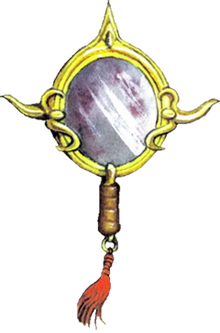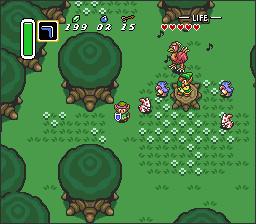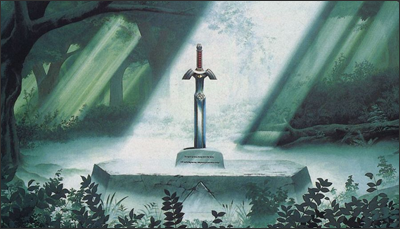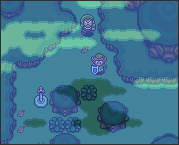Review: A Link to the Past by Hero of Music and Majora’s Cat
Posted on February 18 2011 by Legacy Staff
 The Legend of Zelda: A Link to the Past is a game with some truly revolutionizing techniques that helped shape the rest of the series. It also enhanced many of the techniques from the older games and built upon their themes and stories. But was it a truly amazing game, or was it just an average game that people have over-glorified? Well, we think that it was an amazing game, even though it could be very much improved with today’s technology. We have divided this review into 9 different sections: Story/Plot, Gameplay, Graphics/Presentation, Sound & Music, Dungeons, Difficulty, Replay Value, Legacy/Reception, and a Conclusion. We will explore each of these areas in the review to give our full opinions on the game.
The Legend of Zelda: A Link to the Past is a game with some truly revolutionizing techniques that helped shape the rest of the series. It also enhanced many of the techniques from the older games and built upon their themes and stories. But was it a truly amazing game, or was it just an average game that people have over-glorified? Well, we think that it was an amazing game, even though it could be very much improved with today’s technology. We have divided this review into 9 different sections: Story/Plot, Gameplay, Graphics/Presentation, Sound & Music, Dungeons, Difficulty, Replay Value, Legacy/Reception, and a Conclusion. We will explore each of these areas in the review to give our full opinions on the game.
It’s true, Zelda fans, that A Link to the Past had a sufficient plot for its time, but with the brilliant tales that developers weave into their works these days it’s no wonder we look at A Link to the Past and scoff at its overly simple narrative and typical Zelda chronicle. The princess is kidnapped yet again, there are seven Maidens descended from the Wise men (otherwise known as Sages from other Zelda titles), Ganon has thrown the kingdom of Hyrule into sadness and despair, etc. We all know that clichéd and typical Zelda plot, but that’s one thing about the franchise that probably won’t change. It has become canon in the world of Zelda, so it seems that we gamers will have to get used to it and never expect too much story-wise (what do you know? Nintendo may surprise us).
Still, Nintendo does shoddy work on storylines and ALttP is a direct result of that. Creating believable stories so that the game can fluently progress in a fashion that doesn’t seem forced isn’t exactly Nintendo’s forte. Fans of the series are content with the shallow plot of ALttP and look for salvation in the gameplay instead. Hopefully none of us will put too much faith in the Zelda series having Final Fantasy XIII-quality storytelling. It likely will not happen. That being the case, I can do nothing else but say that ALttP’s plot is mediocre at best.
Still, with all its flaws, A Link to the Past’s story was still good enough to create a supportive frame for the gameplay to flow through. The plot is average or even below standard among Zelda games, so ALttP doesn’t deserve much praise in this area.
Score: 6/10
The Super Nintendo controller had a D-Pad, an L button, a R button, a Start button, a Select button, and 4 standard buttons labeled “A,” “B,” “X,” and “Y.” This control scheme gave the game developers plenty of buttons and controls to play with, which was a distinct advantage over the two games that were made previously. The Nintendo Entertainment System had only a D-Pad, an “A” button, a “B” button and the start and select buttons. The amount of buttons to play around with on the new console led to the creation of new elements that wouldn’t be possible without them. Different actions and responsibilities were assigned to each of the letter buttons: one was your assigned item, one was your sword, one was the “action” button, and one was your map. While the “letter” buttons could have been reassigned better, like the actions assigned to the similar Game Cube buttons, the control system was very easy to pick up and very easy to use. The controls were all very responsive as well. A great new feature in A Link to the Past was the ability to walk diagonally. It increased Link’s mobility greatly, making crossing the screens easier, and more notably, it made evading enemies a lot easier. A few issues with the system include the fact that you could only have one assigned item at a time, you could accidentally push the map button when you wanted your item, and Link walked a little too slow to avoid some attacks. Other than those grievances, the control system was well implemented.
The item system is very similar to that of the original Legend of Zelda and Zelda II: Adventure of Link, and many items from them were reused in A Link to the Past. However, the game also brought some new items to the franchise that have since been used throughout most of the games/series. Items that made their first appearance in A Link to the Past are the Hookshot, the Rods, the three different Medallions, the Bug Catching Net, the Book of Mudora, the Master Sword, the Canes, the Magic Cape, the Pegasus Boots, the Power Glove, the Titan’s Mitt, Zora’s Flippers, and even the Bottle system. The ever important Pieces of Heart also made their debut in A Link to the Past. Some of the items have been “updated” in newer games, and sadly, some of them have yet to make a reappearance. The items in A Link to the Past are relatively easy to use and the item system is a definite improvement over the first two installments in the Zelda series.
 Another new element to the gameplay of A Link to the Past was the Dark World. The Dark World added a new element to Zelda that has been repeated in later games. The Dark World gave A Link to the Past a completely different overworld that was parallel to the original in the Light World. Being able to quickly switch from the Dark World to the Light world was really simple; just a wave of the Magic Mirror transported you right back to the Light World. The only problem with the system was getting from the Light World to the Dark World. While there are several areas that you can use to transport to the Dark World, they were very scattered and often in awkward places to reach. It’s easy to understand that they did this to keep the player from going to the next (or far distant) dungeon if they weren’t ready, but if they had given the player another item after all of the portals had been found that allowed instant switch between the two, it would have made the system much better and easier to use. The two overworlds were a great addition to Zelda that I want to see implemented in more of the future games.
Another new element to the gameplay of A Link to the Past was the Dark World. The Dark World added a new element to Zelda that has been repeated in later games. The Dark World gave A Link to the Past a completely different overworld that was parallel to the original in the Light World. Being able to quickly switch from the Dark World to the Light world was really simple; just a wave of the Magic Mirror transported you right back to the Light World. The only problem with the system was getting from the Light World to the Dark World. While there are several areas that you can use to transport to the Dark World, they were very scattered and often in awkward places to reach. It’s easy to understand that they did this to keep the player from going to the next (or far distant) dungeon if they weren’t ready, but if they had given the player another item after all of the portals had been found that allowed instant switch between the two, it would have made the system much better and easier to use. The two overworlds were a great addition to Zelda that I want to see implemented in more of the future games.
A Link to the Past is a very playable game. The controls are easy to grasp, the items are easily used, and Link is very responsive to received commands. Players of all ages can expect very satisfying game-play from A Link to the Past.
Score: 9/10
A Link to the Past’s beautiful 16-bit graphics are impressive even today. There is no lack in crispness, no single detail not fine-tuned to perfection. The presentation is a bit dated, yes, but the refinement is beautiful and the game looks clean enough to eat off of. Environments in A Link to the Past are far more distinguished and each has its own look so you won’t be getting confused like in the original NES classic. Many staple locations of the franchise made their debut here; such classics as Kakariko Village and Lake Hylia were vividly brought to life by the new graphics (at the time).
While the fine lines that form shapes and whatnot in the overworld look smooth and are not pixilated from a distance, once A Link to the Past is framed up close or on a large HD TV, it’s safe to say that the game will look a lot less impressive. Frame-rate is very important when it comes to graphics. A low frame-rate makes the animations look very “jumpy” and unclean, while a high frame-rate allows for seamless transitions between the generated animations. It is rather remarkable that ALttP is able to handle so much onscreen activity, but that comes at a cost. The frame-rate is relatively low, especially when there are characters and enemies flying all around the screen. The still environments look great, while environmental animation could’ve been handled a tad bit better. Enemies on the screen are the most impressive visually, being considerably more detailed than their surroundings.
Compared to the current generation of video games, ALttP still holds up with clean-cut textures and some of the best visuals of its time. However, the presentation in the game was deficient to say the least. Cutscenes are noticeably lacking in many areas where you might expect them to be present, and most of the presentation consists of onscreen text. Still, cutscenes and visual presentation were not of the highest concern in the late ‘90s, so it’s only natural that ALttP doesn’t sport slick, detailed graphics that you would see in the current generation.
Score: 8.25/10
 When I think of Zelda music, my mind jumps to the classic Overworld theme. A Link to the Past created great versions of the music of Zelda that have inspired the composers to return to that specific style of the series’ themes. While Koji Kondo was limited with the technology of the time, he obviously succeeded at making masterpieces with MIDI renditions of his music. The music in A Link to the Past has distinctive melodies, wonderful harmonies and driving bass lines that make the music some of the best MIDI music of the time.
When I think of Zelda music, my mind jumps to the classic Overworld theme. A Link to the Past created great versions of the music of Zelda that have inspired the composers to return to that specific style of the series’ themes. While Koji Kondo was limited with the technology of the time, he obviously succeeded at making masterpieces with MIDI renditions of his music. The music in A Link to the Past has distinctive melodies, wonderful harmonies and driving bass lines that make the music some of the best MIDI music of the time.
Some of my favorite songs from the game are the Overworld theme, the Dark World theme, and both of the Dungeon themes. Each song has its own distinct feel, yet it all ties back to its roots. Koji Kondo did an excellent job composing each of these songs and used the correct MIDI instrumentation to totally tie all of the different parts together. The repetitiveness of the songs helps you remember them for a very long time. And that’s not a bad thing. I really enjoy humming the songs and it makes me want to smile whenever I hear or think about the music.
Now, the sound effects in A Link to the Past are just “alright.” Don’t get me wrong, the sound effects were great back in the day, but now, they just can’t really compare to the beautiful sounds we hear in video game music today. Sounds were constantly reused and were not the best of quality. However, the sound effects in A Link to the Past have obviously been improved in the newer games. The Chest Opening jingle is one of those sounds. Everyone knows it and some people use it in their everyday lives. The sounds may not have been super high quality, but they helped define the game and the series.
Score: 9.5/10 for Music
Score: 7.5/10 for Sound
The Dungeons in A Link to the Past are some of the best dungeons in the entire series. The dungeons are a complete improvement over those of the two previous installments in the series. Each dungeon has its own unique feel to it and as the game progresses, the difficulty of each dungeon increases, like it should. With a whopping 11 dungeons, there is a lot of game to go around.
The first three dungeons, The Eastern Palace, The Desert Palace, and the Tower of Hera are all fairly straightforward dungeons that mainly serve to introduce the player to the game. But as soon as the plot twist hits, the dungeons get harder and harder to get through. The Dark Palace’s more challenging puzzles and slightly different layout influenced the rest of the dungeons to progressively do the same. The Swamp Palace added different strategies for defeating enemies and added the element of water to the layout. The Skull Woods had multiple entrances to the dungeon, adding a different type of challenge. The Gargoyle’s Domain had a different type of boss that relied on light to be defeated. The Ice Palace added a whole new element to the dungeon through ice patches that had to be crossed. The Misery Mire added increasing amounts of spikes and multiple types of enemies at once. And Turtle Rock added a new “riding the platform” aspect to the dungeon that made it much harder than it would have been without it. Each dungeon added new elements to those of previous dungeons. Then there’s the last dungeon, Ganon’s Tower. This dungeon had elements from all of the previous dungeons, and was yet harder than the last. The reason that each dungeon gets harder is largely due to the fact that the player is progressing through the game. So adding each of these new elements is essentially training the player to learn and adapt to new puzzles to train them for their final challenge.
Overall, the dungeons in A Link to the Past were all satisfying and wonderful to play. They provided the perfect difficulty with great puzzles and length. The dungeons are one of the best parts of the game.
Score: 10/10
A Link to the Past is considered on the harder side of the Zelda series. Other games like Adventure of Link, the original Legend of Zelda, and the Oracle games might be a little harder than A Link to the Past, but A Link to the Past still holds its own.
For beginners to Zelda or the overhead perspective, A Link to the Past can seem like a difficult game at first. It can be hard to understand what each of the buttons do, but like most of the other Zelda games, the developers created a learning curve to slowly feed the game to the beginners. But be warned, once they’ve taught you, the game bumps the difficulty up and continually turns it up a notch with each dungeon and area explored.
For players that are experienced at all of the other Zelda games, the game is fairly easy to get a hold of. These players can instantly jump into the complexity of the game, and can usually speed right through the first dungeon. But if the player isn’t careful, they can become overconfident and make mistakes that get them killed.
Another thing about the difficulty of the game was the amount of damage that certain enemies did to you. There are some very powerful enemies that can be found in various places in the Dark World that can do some serious damage to your health. These enemies are found in the middle of the game in places that are easy to access. So, either be brave and learn how to dodge their attacks so that you can go in for the kill, or just completely avoid them like most do.
For both the experienced and the beginners, don’t get frustrated if your death count starts climbing. Enemies that can attack you while you’re trying to run, balls that come rolling at you, spikes that shoot out of the ground, and many other things can damage you and will eventually cause you to die. These constant deaths can really annoy many people. But, for those that are patient and careful, the game can be really fun, challenging, and have the perfect level of difficulty. A Link to the Past’s difficulty is perfect for people that hate overly complicated puzzles and for people looking for a fun challenge.
Score: 8.75/10
A Link to the Past is rather short compared to its 3D successors, granted, but perhaps that’s what compels gamers to play it over and over, never getting tired of it. Game Informer states in its special 200th issue that “A sure-fire sign of a great game is its ability to stand the test of time, and Link to the Past remains a blast today”. But I believe it’s the simplicity of the graphics and the nostalgic gameplay that keep gamers coming back for more. The charming look and feel combined with the perfect length is probably the most attractive part of the package.
Games like Twilight Princess and Wind Waker were just a tad bit too long for me go back and play from the start again, so I usually put them off until I long for their sweet embrace once again. ALttP is an entirely different story, though. Wind Waker was plagued with boring sailing, and one of the great things about A Link to the Past is there’s less useless traveling and more action. Traversing the land may not have been straightforward, but many still prefer the nostalgic 2D style and find it entertaining to visit Hyrule in 2D once more. With less tediousness and more “straight-to-the-action” gameplay, the Zelda franchise’s third release is likely one that gamers will want to play time and time again.
Score: 9.5/10

Where to begin? First off, A Link to the Past was probably the first Zelda game to successfully create an interactive overworld, detailed and varied enemies, and also the first to introduce many classic locations that would become reused in Ocarina of Time, TP, etc. The game has been universally known as the second time the Zelda series has changed the face of gaming. The first being the original Legend of Zelda, the third being Ocarina of Time.
A Link to the Past was an innovation in 2D gaming, creating a more detailed world than we had ever seen the likes of. ALttP would then serve as the golden standard of 2D Zelda games that all were compared to. The Minish Cap, Four Swords games, the Oracle series, and virtually all other main 2D installments (that do not predate ALttP or are sequels to Wind Waker) have similar visuals and gameplay structure to the series’ SNES masterpiece.
Now to get down to the nitty-gritty of the honors the game has received. Game Informer magazine placed A Link to the Past as the 12th greatest game of all time in their 200th issue. IGN placed ALttP 11th in its “Top 100 Games” in the year 2005. Readers voted it to a spot quite high on the list, placing it 5th among the best games. In 2006, Entertainment Weekly chose the game as the greatest of all time. On GameFAQs the game placed 4th according to its members, Famitsu ranked it as the 31 best and in July, 2007, readers of Edge gave ALttP the honor of being number 6 on the 100 best games of all time. Official Nintendo Magazine gave ALttP the 8th spot in its top 100 Nintendo games. As you can see, ALttP has garnered tremendous popularity over the years and is seen as one of Nintendo’s greatest masterpieces. Its impact on the Zelda games to come is unquestionable; therefore, I cannot do anything other than give ALttP the highest possible score.
Score: 10/10
The Legend of Zelda: A Link to the Past has left a gargantuan crater in the world of video games and made way for many installments to come. Not many games can say as much. Although A Link to the Past wasn’t the Zelda game that started it all, it sure did add a layer of refinement yet to be seen. While the Legend of Zelda was the backbone of the series, ALttP added the flesh and skin.
Overall Score: 9.5/10
This article was co-written by Zelda Dungeon users Hero of Music and Majora’s Cat.




